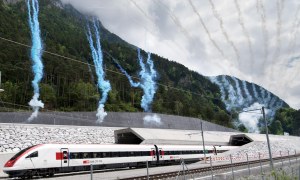🕑 Reading time: 1 minute
Contents:
What is Rebar?
Steel reinforcement bars or rebars are used to improve the tensile strength of the concrete, since concrete is very weak in tension, but is strong in compression. Steel is only used as rebar because elongation of steel due to high temperatures (thermal expansion coefficient) nearly equals to that of concrete.
Fig 1: Reinforcement Steel Bar
Grades of Rebar in Different Codes
Table 1: Grades of Rebar in Different Codes| American Standard (ASTM A 615) | Euro Standard(DIN 488) | British Standard BS4449: 1997 | Indian Standard (IS: 1786) |
| Grade 75 (520) | BST 500 S | GR 460 A | Grade Fe – 415, Fe – 500, Fe – 500D |
| Grade 80 (550) | BST 500 M | GR 460 B | Grade Fe – 550 |
Types of Steel Reinforcement Bars
1. Mild Steel Bar
The surface of the mild steel bars are plain and round in shape. They are available in various sizes of 6 mm to 50 mm. They are used in concrete for special purposes, such as dowels at expansion joints, where bars must slide in a metal or paper sleeve, for contraction joints in roads and runways, and for column spirals. They are easy to cut and bend without damage.
Fig 2 : Mild Steel Bar
Grades in mild steel bars
- Mild steel bars grade-I designated as Fe 410-S or Grade 60.
- Mild steel bars grade-II designated as Fe-410-o or Grade 40.
Physical Requirement of Mild Steel Bars
Table 2:Physical Requirement of Mild Steel Bars| Types of Nominal size of bar | Ultimate Tensile Stress in N/mm2 | Yield Stress N/mm2 | Elongation Percentage min |
| Mild Steel Grade I or Grade 60 | |||
| For Bars upto 20mm | 410 | 250 | 23 |
| For Bars above 20mm upto 50mm | 410 | 240 | 23 |
| Mild Steel Grade II or Grade 40 | |||
| For Bars upto 20mm | 370 | 225 | 23 |
| For Bars above 20mm upto 50mm | 370 | 215 | 23 |
| Medium Tensile Steel Grade -75 | |||
| For Bars upto 16mm | 540 | 350 | 20 |
| For Bars above 16mm upto 32mm | 540 | 340 | 20 |
| For Bars above 32mm upto 50mm | 510 | 330 | 20 |
2. Deformed Steel Bar
Types of Deformed Steel Bars
1. TMT Bars (Thermo Mechanically Treated Bars)

Fig 3: Deformed TMT Steel Bar
Characteristics of TMT Rebars
- Better ductility and malleability
- High yield strength and toughness
- More bonding strength
- Earthquake resistance
- Corrosion resistance
- High thermal resistance
- Economical and safe in use
- No loss in strength at welded joints
- Ordinary electrodes used for welding the joints
2. High Strength Deformed Bars
High strength deformed bars are cold twisted steel bars with lugs, ribs, projection or deformation on the surface. It the extensively and majorly used for reinforcement purposes in a construction. These bars are produced in sizes or sections from 4 mm to 50 mm in diameter.
Fig 4: Deformed HSD Steel Bar
Characteristics of HSD Rebar
- Low carbon value - HSD Bars have lower carbon level, resulting in good ductility, strength and welding ability.
- Superior bonding strength - HSD bars are well known for their excellent bonding strength when used with concrete.
- Welding capability - Since these bars have lower carbon content, they have 100% welding capability than conventional bars.
- High tensile strength - HSD bars feature high tensile strength. They offer great asset in construction process, where a lot of bending and re bending is required.
- Wide application range - These bars have wide application range like in building residential, commercial and industrial structures, bridges, etc.
- Satisfactorily malleability - Minimum weight and maximum strength and suitable for both compression and tension reinforcement.
3. Other Types of Rebars
1. European Rebar
European rebar is made of manganese, which makes them bend easily. They're not suitable for use in areas that are prone to extreme weather conditions or geological effects, such as earthquakes, hurricanes, or tornadoes. The cost of this rebar is low.2. Carbon Steel Rebar
As the name represents, it is made up of carbon steel and is commonly known as Black Bar due to carbon colour. The main drawback of this rebar is that it corrodes, which adversely effect the concrete and structure. The tensile strength ratio coupled with the value makes black rebar one of the best choices.
Fig 5: Carbon Steel Rebar
3. Epoxy-Coated Rebar
Epoxy-coated rebar is black rebar with an epoxy coat. It has the same tensile strength, but is 70 to 1,700 times more resistant to corrosion. However, the epoxy coating is incredibly delicate. The greater the damage to the coating, the less resistant to corrosion.
Fig 6: Epoxy-Coated Rebar
4. Galvanized Rebar
Galvanized rebar is only forty times more resistant to corrosion than black rebar, but it is more difficult to damage the coating of galvanized rebar. In that respect, it has more value than epoxy-coated rebar. However, it is about 40% more expensive than epoxy-coated rebar.
Fig 7: Galvanized Rebar
5. Glass-Fiber-Reinforced-Polymer (GFRP)
GFRP is made up of carbon fibre. As it is made up of fibre, bending is not allowed. It is very resistant to corrosion and is costly when compared to other rebars.
Fig 8: Glass-Fiber-Reinforced-Polymer Rebar


